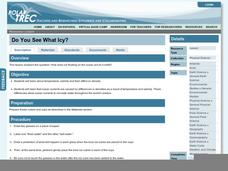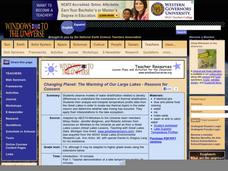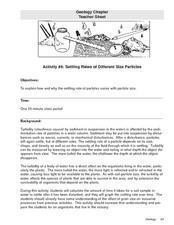Teach Engineering
Density Column Lab - Part 2
Groups suspend objects within layers of liquids to determine the densities of different liquids and compare them to the densities of objects calculated in Part 1. The groups then carefully test their calculations by layering the liquids...
Teach Engineering
Density Column Lab - Part 1
Mass and density — aren't they the same thing? This activity has groups use balance beams and water displacement to measure several objects. The pupils use the measurements to calculate the density of the objects.
Polar Trec
Nature's Density Column
Nature provides density columns in the polar regions that provides food for many animals. Young scientists build their own density columns with water in order to answer analysis questions. Through a slideshow presentation, scholars...
Teach Engineering
Density and Miscibility
The liquids did not mix — so what do density columns have to do with it? The seventh part in a series of nine provides the theoretical explanation of why density columns do not mix. The lesson covers the topics related to mixing and...
Curated OER
How Sweet It is! A Colorful Sugar Solution Density Column
Students examine the affect of density. Using a graduated cylinder and equally prepared volumes of sugar-water solutions and food color, students observe a sugar rainbow. They discover that the greater the amount of sugar in the...
Curated OER
Density Columns
In this density worksheet, high schoolers answer 12 questions about the density of substances. They read a diagram of a graduated cylinder and determine the volume, mass of water. They interpret a diagram with three liquids and indicated...
Curated OER
Density and Buoyancy Lesson Plan
Students investigate why some objects float or sink in water. In this physics lesson, students calculate the density of clay ball using a mathematical equation. They write a complete lab report about the experiment.
Curated OER
Buoyancy-Why Things Float
In this buoyancy worksheet, students read about the principles behind objects floating including density, buoyancy and Archimedes' Principle. Students complete a buoyancy lab where they use a balloon and water and a film canister and...
Curated OER
Buoyancy
In this buoyancy worksheet, students read about why objects float or sink. Students apply the Archimedes' Principle in a buoyancy lab. Students complete 1 graphic organizer.
Polar Trec
Do You See What Icy?
Here is a lesson that kicks off with a question. "How does ice floating on the ocean act as it melts?" As learners investigate this natural phenomenon, they'll discover that it has a lot to do with temperature, salinity, and the effect...
Curated OER
Changing Planet: The Warming of Our Large Lakes - Reasons for Concern
Another A+ lesson on the impact of climate change comes to you from the National Earth Science Teachers Association. In this installment, learners model the stratification of water in lakes due to temperature differences. The lab also...
Curated OER
Settling Rates of Different Size Particles
Students discover how and why the settling rate of particles differs with the size of the particles. Using different soil samples, they calculate the amount of time it takes for a sample to settle in water for up to forty minutes. They...
Curated OER
How Big Is That Star?
Aspiring astronomers study stars. They compare stars and explain the relationship between radius, mass, and diameter. By creating a star simulation, they discover how a binary star system's orbit can cause changes in the observed...
Curated OER
Physical Difference and Classification
Students use a microscope and observation skills to compare and contrast several physical properties and develop a classification system.















